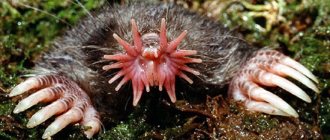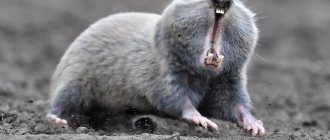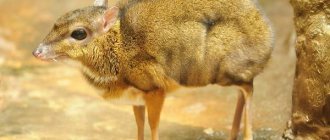- Wild animals
- >>
- Mammals
There are a lot of animals in nature that know how to dig tunnels underground. However, the most famous digger, known since childhood, is the mole . This mammal spends most of its life underground, which is facilitated by the special body structure and physical capabilities of the mole. This is a unique creation of nature, which brings both unconditional benefit and quite serious harm to humans.
Origin of the species and description
Photo: Mole
The mole is a very small animal with tiny eyes and strong paws that have the ability to dig through long underground passages. The eyes of some mole species are securely hidden under the skin. Moles do not have ears; they have smooth, very soft fur. The coat color is usually black, but there are also animals with a dark gray “fur coat”.
Moles are classified as insectivores, which belong to the broad class of mammals. They are part of the mole family - lat. Talpidae. The animals got their name for a reason. Literally, the word “mole” means “digger.” The name comes from the word “dig, dig.”
Video: Mole
These underground inhabitants can make passages hundreds of meters long. Under the soil, the animal arranges a sleeping place for itself and makes special corridors in which it hunts. Moles prefer to spend the night on moss, grass or leaves. They are quite intelligent animals, so a secret passage is always provided in the “bedroom” for retreat in case of danger. The underground passage is covered with bedding.
Interesting fact: Constant movement through narrow earthen passages is reflected in the appearance of the animal. Gradually, the mole wears off its fur, remaining completely bald. However, nature has provided for everything - moles grow a new “coat” 3-4 times a year.
Moles also equip their homes with additional passages to a water source. Some animals create their own underground wells. Wells fill with water during heavy rains. In winter, such animals prefer to hide deep in the ground. At great depths, the earth remains warm and does not freeze.
How deep is a mole hole? How and to what depth does a mole dig the ground?
Many people only know about the small animals living in the village from cartoons. We are talking about moles. Not many have seen them in the natural environment. And when they noticed it and examined it, they got scared. Their forelimbs look so bright. And, of course, not every person can tell how deep a mole’s hole is. For non-specialists, this interesting topic often remains a “closed secret.” But in fact it is quite educational. Not only biologists, but also people of other specialties study this topic in detail, keeping in mind its practical application. Let's not lag behind either. It might come in handy!
Appearance and features
Photo: Animal mole
The main feature of these small animals is the lack of vision. If for humans and other animals the lack of vision is a serious defect, then for moles it is considered the norm and even a necessity. Having normal eyes, these animals simply would not be able to spend almost their entire lives underground. Moles have eyes, but in most species they are additionally protected by a layer of skin.
Not only the organs of vision are completely adapted to underground life. The hearing organs are also adapted to it. Moles do not have ears. This is also not just provided by nature. If there were ears, then too high pressure would form in them. Such pressure would not allow the animal to be in the soil.
Diggers have fur that is very pleasant to the touch. It also has some features that differ from the fur of other animals. The mole fur covering can be easily folded in different directions. This property allows animals to slip into narrow underground tunnels without problems. The color of the fur is usually black, brown or dark gray.
The appearance of moles can be characterized by the following parameters:
- The total length of the animal is about sixteen centimeters. Of this, the body occupies approximately seven centimeters, and the rest is the length of the head and tail.
- The average weight of the animal is fifteen grams. However, representatives of the family of larger sizes are known. For example, scientists came across the Ussuri mogera, whose length is twenty-one centimeters.
- The body shape of this mammal is bar-shaped. Moles have a tiny head and an almost invisible neck. The auricles of most members of the family are undeveloped, while in others they are very small and covered with hair. Animals also have a nose in the form of a small proboscis. It contains sensitive hairs. The nostrils are directed forward.
- The mammal's paws have five toes. They are the main tool for digging long tunnels. The paws are strong and have claws. The hands resemble shovels; they are turned with the palms facing outward. The mole digs tunnels with its front legs, while its hind legs are less strong. They are very thin and resemble the paws of rats.
Where does the mole live?
Photo: Soil animal mole
Representatives of the mole family are widespread. They live throughout Eurasia and North America. In South America, moles are completely absent. Scientists have concluded that these animals settled in North America when it was separated from the South by the Strait. Moles live in especially large numbers in Russia, Belarus, Poland, Ukraine, Georgia, and Moldova.
In particular, four species of moles live in Russia:
- Blind. It is distributed from Ciscaucasia to Transcaucasia. Representatives of this species can often be found in Turkey and even in Northern Iran. The animal lives in mountains, alpine meadows, and is sometimes found in forest landscapes. To live, blind moles choose loose, moist soils. Sometimes these animals live together with the Caucasian species;
- Caucasian. It settles in the central, western parts of the Caucasus, and is found in some areas of Turkey, which are adjacent to the shores of the Black Sea. Caucasian moles live mainly in deciduous forests, but in small numbers they are found in mountain meadow biotopes. In search of food, such animals can go to a depth of up to one meter. The main passages are located quite close to the surface - at a distance of five centimeters;
- Altaic. It has a uniform coat color, the fur on the belly is matte. The appearance of Altai moles is completely consistent with moles. The body of the animal is quite massive and round;
- Ordinary. This is the group of the most common moles. Its representatives can be found in various landscapes: from forests to mountains.
For a normal life and reproduction, moles need special conditions. For this reason, they choose areas with moist soil. It is most suitable for digging tunnels. The terrain of the area can be almost anything. The animals prefer a moderate climate.
What does a mole eat?
Photo: Mole insectivore
Moles, although small, are quite voracious animals. They are active around the clock, but hunt more often at dusk. Animals have a high metabolism. In summer, moles eat in large quantities, and in winter, the diet and amount eaten decrease slightly. Animals prefer to live and hunt alone, but sometimes there are also representatives of the family living in groups.
The main part of the mole's diet is earthworms. Mammals eat them in the summer and store them for the winter, biting off the heads of the worms, paralyzing them. Moles also eat larvae of earthworms, larvae of click beetles, May beetles and other varieties of beetles. Flies, caterpillars, and slugs often end up in mole food.
The largest representatives of the mole family, mogers, prefer to feed on butterfly caterpillars. Star-nosed moths eat small aquatic inhabitants. They can feast on crustaceans, small fish and insects. American shrews include plant foods in their diet.
Interesting fact: A tiny mole can eat a huge amount of food in a day. The animal absorbs food, the weight of which is equal to the weight of the animal itself. Also, these mammals are quite thrifty. A mole can store about two kilograms of food in its nest for a rainy day.
In one day, the number of meals can reach six times. After each hearty meal, the mole falls asleep sweetly. Sleep duration is usually four hours. It is during this period of time that the food has time to be completely digested. The animals are not used to going hungry. They can live no longer than seventeen hours without food.
To find a fresh treat. moles do not have to dig new passages every time. They find food in old tunnels into which the worms crawl on their own. Worms are attracted due to the warmth and special smell of moles. In winter, members of the family also do not have to starve. Earthworms are no less active. They are able to make moves even in frozen ground.
Features of character and lifestyle
Photo: Common mole
Almost the entire life of a mole is spent in complete darkness. They build incredible labyrinths in which they then live and hunt. Labyrinths can lie at different depths in the ground. Digging takes an animal a lot of time. Above the passages, which are located close to the surface of the earth, you can always notice a characteristic roller. The depth of the labyrinths depends on the type of soil. If it is loose and wet, the passages are made at a shallow depth; in dry soil, channels are dug at a depth of twenty centimeters.
The deepest tunnels are dug by animals under forest paths. Nests are also located at great depths. On average, females build nests at a depth of 1.5 meters. The nest is carefully lined with grass and leaves. Animals can from time to time roam around the area where they live. In the summer they descend to the lowlands, in the spring - to the hills. In spring, male moles can expand their territory several times. This is due to the search for a female for reproduction.
Moles have a contradictory character. They are grumpy and quarrelsome. Very rarely animals live in a group. They unite in pairs only when the time comes for the mating season. Moles show friendliness only at a young age. Young individuals caress each other. But with the process of growing up, not the best qualities begin to appear - grumpiness, pugnacity.
Adults often start fights if they meet each other on the way. They are capable of mercilessly biting to pieces an opponent. It is not surprising that in captivity, representatives of the family eat the meat of their relatives with great appetite. Also, moles do not have empathy. If their neighbor gets into trouble or dies, there will be no help. Moles quickly occupy the tunnels of the dead animal and use it for their own purposes.
Reasons for appearing on the site
The first and main reason for the appearance of moles on the site is that the population has become crowded with neighbors. Given the high need for food, animals do not live in large families. Young individuals leave their parental territories in search of their own domains. They give preference to places with loose soil rich in organic matter. It is much easier to dig, and the productivity of work will be higher: in such an environment there are always more earthworms.
So if you actively mulch the beds with organic matter, or have set up a compost heap, then for the mole they will be the best argument for moving to the site. Nearby water sources will count towards the common benefits.
Social structure and reproduction
Photo: Mole wild animal
Representatives of the mole family reproduce once a year.
However, the number of moles and the breeding season differs among different species:
- The Siberian breeds in June. However, offspring appear only a year later, in the spring. On average, pregnancy lasts about two hundred and seventy days. At one time, the female gives birth to no more than six cubs;
- The Caucasian prefers to mate in February, and moles appear in March. No more than three cubs are produced at a time. The brood becomes independent within forty days after birth. Representatives of this species increase their numbers very quickly, because the offspring appear very deep underground. He is in no danger;
- The European mate in the spring - during March and April. Forty days after meeting the male, the female gives birth to moles - about nine individuals at a time. The weight of one cub, as a rule, does not exceed two grams;
- Blind. It breeds in February; the gestation period for the young is one month. The female gives birth to about five individuals at a time.
Interesting fact: The lifespan of a mole depends on its species. On average, members of the family live from three to five years.
How should the trap be set?
The only way to neutralize a mole and stop its activity on the site is by driving it away or destroying it. The first method does not always help; it happens that the mole stubbornly does not want to leave its home. Then you will have to act differently - set a trap.
Attention! See our rating review of the most effective mole traps based on reviews from gardeners.
Mole passages underground have temporary and permanent uses. The latter are of interest, since the animal uses temporary ones once to feast on worms. It does not compact the walls of the hole; they quickly crumble and there is no point in reusing them.
Natural enemies of moles
Photo: Mole underground animal
Representatives of the mole family have few natural enemies. They can only be harmed by birds of prey, wild boars, badgers, and martens. Such animals often die from an arid climate, too much moisture, or at the hands of humans themselves. People kill animals either intentionally or accidentally. Some are trying to catch the mole and domesticate it. But such an undertaking also ends in the death of the animal.
Also, a small number of adult individuals die from the paws of their relatives. Adult moles are quarrelsome and pugnacious, so fights between them are not uncommon. Fights usually end with the death of one of the fighters.
Interesting fact: Moles have no natural enemies, only underground. If the animal does not climb to the surface of the earth, then nothing threatens it.
What is a wormhole
Let's start with the fact that this animal does not really like to look out into the white light (if you can say that about it). The fact is that the mole is blind due to his lifestyle. Its habitat is the upper layers of soil. There he feels quite comfortable and cozy. Before asking how deep the mole's hole is, you need to find out why he needs it. After all, such a “structure” depends on goal setting. Nature does not like empty movements. In any case, the wormhole proves precisely this principle. The animal devotes almost all its time to its work on “underground construction”. He debugs and improves it. A wormhole is a whole system of corridors and rooms, each of which is created for its own purpose. There are passages, a latrine, a nest, and a warehouse. Of course, all terms should be placed in quotation marks. However, they carry a practical load very similar to that which we put into the corresponding names. For example, a latrine is used by an animal as a “toilet room.” Moreover, in other places the animal does not fulfill this natural need.











